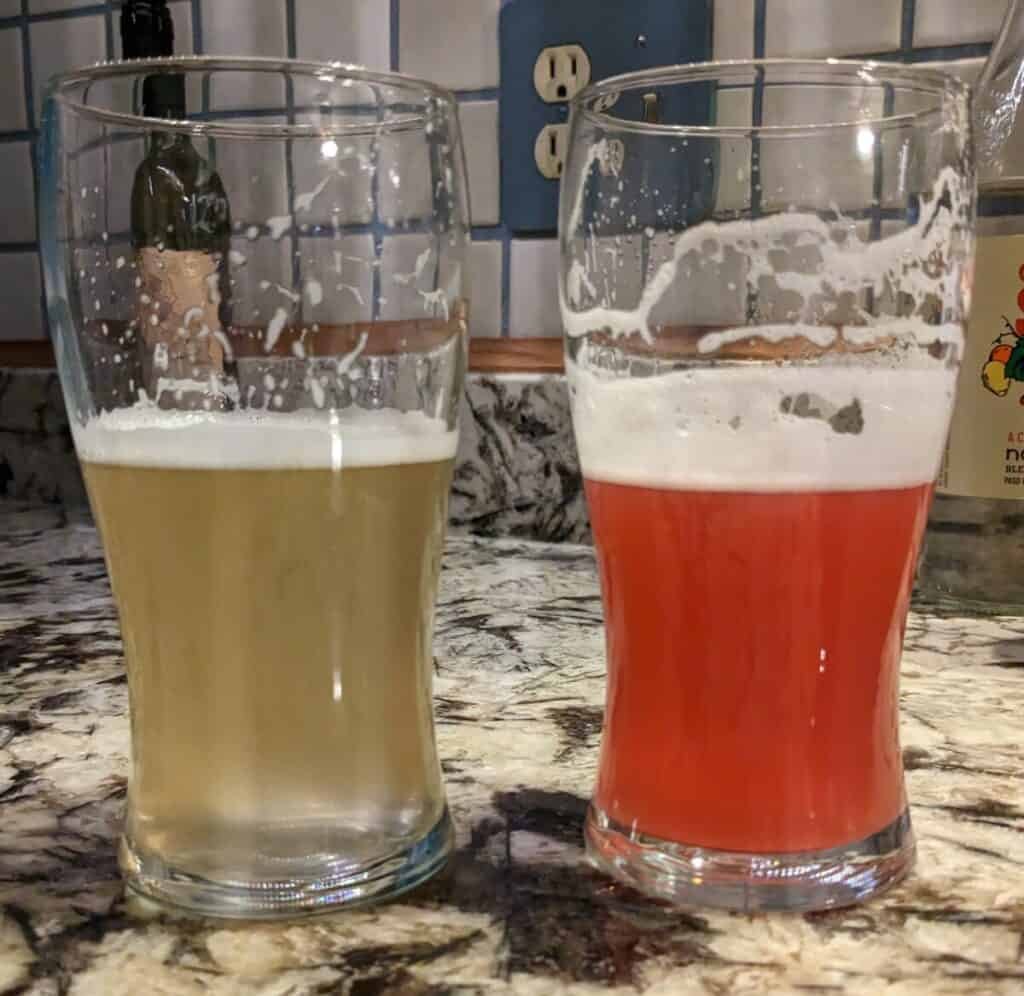What is a Berliner Weisse Ale?
According to the BJCP guidelines (2021), a Berliner Weisse is “a very pale, refreshing, low-alcohol German wheat beer with a clean lactic sourness and a very high carbonation level. A light bread dough malt flavor supports the sourness, which shouldn’t seem artificial. A gentle fruitiness is found in the best examples.”
Now THAT sounds like a refreshing beer, especially during spring and summertime!
And Berliner Weisse lends itself to be easily modified with fruit! So, for this batch, I decided to try it with and without a combination of raspberries and blackberries.
BJCP Category: 23A/29A
I ended up splitting this batch into two fermenters where one batch had raspberries and blackberries added midway through fermentation and the other was left as is.
| As Is Batch | Fruited Batch | |
| BJCP Category | 23A Berliner Weisse | 29A Fruit Beer |
| ABV | 2.8–3.8% | 2.0–10.0% |
| OG | 1.028–1.032 | 1.020–1.090 |
| FG | 1.003–1.006 | 1.006–1.016 |
| IBU | 3–8 | 5–50 |
| Color (EBC) | 3.9–5.9 | 3.9–98.5 |
Recipe
Here’s a link to the recipe in Brewfather: Berliner Weisse
Vital Stats
| Stat | Value |
|---|---|
| OG | 1.035 |
| FG | 1.011 |
| ABV | 3.2% |
| Color | 5.5 EBC (calculated by Brewfather) |
| IBU | 6 |
| Boil Time | 30 minutes |
| Batch Volume | 18 L/4 US gallons |
Fermentables
| % | kg | lb | Grain/Adjunct |
|---|---|---|---|
| 53.8% / 39.4% | 1.325 | 2.921 | Briess White Wheat Malt |
| 46.2% / 33.8% | 1.136 | 2.504 | Avangard Pilsner Malt |
| 0% / 17.9% | 0.6 | 1.323 | Raspberries |
| 0% / 8.9% | 0.3 | 0.661 | Blackberries |
Mash Profile
| Step | Temperature (°C) | Temperature (°F) | Time (minutes) |
|---|---|---|---|
| Saccharification Rest | 63 | 145 | 90 minutes |
| Mash-out | 75 | 167 | 10 minutes |
Water Profile
| Ca2+ (ppm) | Mg2+ (ppm) | Na+ (ppm) | Cl– (ppm) | SO42- (ppm) | HCO3– (ppm) | pH |
|---|---|---|---|---|---|---|
| 31 | 1 | 71 | 86 | 60 | 57 | 5.11 |
To my source water, I added 2.2 g calcium chloride, and 2 mL lactic acid. After 10 minutes into the mash, I took an aliquot and cooled the sample to 19 °C. The pH measured 5.67. I added 1 mL of lactic acid to the mash, and took another sample after recirculating the wort. I overshot the pH target of 5.2 by a small amount, with a final measurement of 5.11.
Hops
| Hop | Alpha Acid | Time | IBU |
|---|---|---|---|
| Cascade | 6.9% | 15 minutes | 6 |
Yeast
For this brew, I used Philly Sour from Lallemand. This is a yeast that belongs to the Lachancea family that produces lactic acid, in addition to ethanol during fermentation. The yeast consumes glucose during the first few days of fermentation to produce lactic acid, which lowers the pH of the beer, giving the beer a tart finish. To my taste buds, I get a lemony-dough flavor.
Fermentation Profile
| Step | Temperature (°C) | Temperature (°F) | Time/% of Fermentation |
|---|---|---|---|
| Primary | 24 | 75 | 5 days |
| Fruit Addition | 25 | 77 | 4 days |
This beer did not attenuate as much as I thought it would (measured as 68% attenuation, whereas Lallemand claims a 74–82% attenuation range. Final gravity (FG) was 1.011, which gives 3.2% ABV. Not complaining there. The ABV falls within the BJCP guidelines (2.8–3.8% ABV).
Conditioning and Carbonation
The beers were transferred to serving kegs and cooled to 5 °C under 15 psi of pressure for 10 days before opening the taps.
| Step | ||
|---|---|---|
| Conditioning | 5 °C/41 °F | 10 days |
| Carbonation | 15 psi | 2.8 volumes of CO2 |
Recipe Impressions
Both the Berliner Weisse and Fruited Sour Wheat did not disappoint!
The Berliner Weisse had a soft, fluffy white head that would slowly dissipate over the course of drinking the glass. The flavor and mouthfeel were highlighted by a crisp, tart, lemony-dough flavor, with enough carbonation to lightly tickle the tongue.
Likewise, the Fruited Sour Wheat had the same fluffy white head, however, the beer had a lovely bright pink color.
Initially, both beers were hazy, but by the time we finished the keg of the Berliner Weisse, it was brilliantly clear!

Refreshing: Berliner Weisse
For a great, refreshing session beer, brew a Berliner Weisse. There are a lot of options for customizing this beer to your tastes. Throw some fruit in it. Maybe explore throwing some Brettanomyces at it after fermentation is done to see how the beer further develops. It’s a great beer that I’ll be keeping around at my house.

When do I get to try some more of your beers, especially the fruited ones sound verrry interesting.